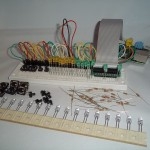This post will be one in a series for all the components available to literally break out the expansion ports from the Pi. This series will cover Breadboarding components to connecting the various Shields and plates that are designed specifically for the Pi.
1. Breakout Kits
Breakout Kits are used to connect the Pi to a breadboard, which comes in handy when prototyping your electronics. There are a few Breakout Kits available for the Pi. Most should come prepackaged with a 26-Pin ribbon cable. And quite a few need assembly. This is a great starter for those with no soldering skill what so ever.
Breakout kits generally do not have any protection circuits in place. And the Pi’s GPIO pins connect directly to the Broadcom system chip so be careful what you attach as overloading the Broadcom chip can damage your Pi beyond repair. Any circuit protection with breakout kits would occur on the breadboard.

Below I will list the most popular kits I can find for sale.
This unit comes as a kit and requires very little soldering skill. The kit sales for $7.95 on Adafruit’s website. This was Adafruit’s first Breakout for the Pi. It is compact and made with high quality components.
Just like the original Cobbler this also comes as a kit and requires very little soldering skill. This kit sales for the same cost of $7.95 on Adafruit’s website. This unit has the distinction of making all the pinouts of the breakout board accessible. This kit is also a bit larger due to the addition of the 26 pin female connector being at the bottom of the board but it is still quite compact.
This one is sold exclusively on eBay. I have not bought one of these yet, but have bought other items from this seller and found them to be quite professional and very friendly. This is the only board that comes assembled. This is very advantageous if you do not wish to solder one together. It’s listed price is $8.99 and shipping to the US is $2.50 which makes it very competitive in cost. It’s best point is definitely the fact that it is assembled and comes with a ribbon cable. For the price it is a steal.
The Breakout Board *PRO from Hobby Tronics has all the bells and whistles you may want on a kit. It does take very little soldering skill as all the hard components are attached. List price is £3.75 and postage to the US is £9.95 so the overall cost is about $22 US. And does not come with a ribbon cable. It has the following components which help make it a good investment.
-
- 3.3V 500mA voltage regulator
- LED power indicator
(Thanks Michael for the find)
2. Breakout Headers
The following kit’s do breakout the pins from the Pi but do not plug directly into a breadboard. So you would need additional jumper wires to tie them into one. These kits are referred to as Headers these are useful if you have a circuit board with pin outs that just need a wire to connect them.
This kit requires very little soldering skill. And does not come with a ribbon cable but does have the cables for sale. This is offered by RK Online from the UK. It’s list price is GBP 2.99 and is approximately $4.79 US. This only utilizes the 20 pins available on the Pi’s GPIO port as up to 6 are listed as Do Not Connect or provide secondary power and ground pins.
This kit is identical to the unit above but comes with a female connection allowing it to stack directly on top of the Pi’s GPIO pins It does not require a ribbon cable. It also needs very little soldering skill and sales for GBP 2.99 approximately $4.79 US. This only utilizes the 20 pins available on the Pi’s GPIO port as up to 6 are listed as Do Not Connect or provide secondary power and ground pins.
The links above are for their eBay store you can also get them directly from RKOnlineStore.co.uk
3. Peripheral Headers
Another function of Breakout Headers is they can be designed to separate the individual pin’s found on the Pi. These are typically referred to as GPIO, Serial UART, SPI, and I2C pins. More info can be found at eLinux RPi Low-level peripherals. Peripheral Headers generally cost a bit more to produce. This is due to the separation of different types of pins found on the Pi. They are usually grouped together with V+ and Grounds along with the various UART, SPI, and I2C pins. Allowing for easier identification of these pins along with the ability to chain various devices off the Pi. Since each set of connectors has it’s own power supply you don’t have to splice a wire off the individual rails. These boards may also contain basic protection components aimed at the typical devices you would attach to these components. They may also have the ability to set voltages between the 5v and 3v rails.
For more detail: Boards – Breakout the Pi – I2C, UART, GPIO and More Board


